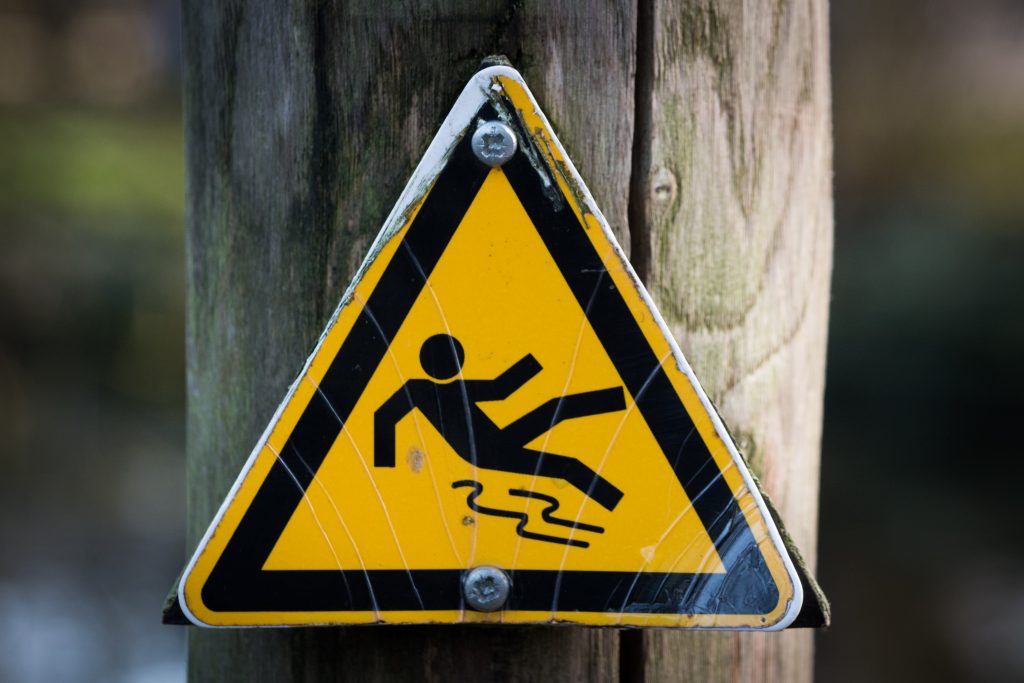 Slip and fall cases can have a bad reputation. You know the scenario: Person A slips while on Person B’s floor and sues Person B for everything he has. Oftentimes in this scenario, Person A barely got hurt and may have been able to take steps to have helped prevent the injury. While there are some cases like this that make us ask why people are even allowed to sue in this scenario, there are also cases where people get seriously injured and need to be made whole again. These cases also show that those who allow others onto their property or premises have different responsibilities to ensure that the conditions are reasonably safe. Maintaining these responsibilities is essential so that people can go to these places with the expectation that they can enjoy the premises without worrying if the conditions are hazardous. One example is a slip and fall case that was filed in the 22nd Judicial District Court in Washington Parish, Louisiana.
Slip and fall cases can have a bad reputation. You know the scenario: Person A slips while on Person B’s floor and sues Person B for everything he has. Oftentimes in this scenario, Person A barely got hurt and may have been able to take steps to have helped prevent the injury. While there are some cases like this that make us ask why people are even allowed to sue in this scenario, there are also cases where people get seriously injured and need to be made whole again. These cases also show that those who allow others onto their property or premises have different responsibilities to ensure that the conditions are reasonably safe. Maintaining these responsibilities is essential so that people can go to these places with the expectation that they can enjoy the premises without worrying if the conditions are hazardous. One example is a slip and fall case that was filed in the 22nd Judicial District Court in Washington Parish, Louisiana.
Grady Wayne Bryant was in a Popeye’s parking lot when he slipped on grease while stepping off the curb. He and his wife filed a lawsuit against the restaurant’s company, Premium Food Concepts, Inc. and its insurer, State Farm Fire and Casualty Company. The company denied the Bryant’s allegations and filed a motion for summary judgment, claiming that the Bryants could not show that Popeye’s created the grease that caused the accident or that Popeye’s had constructive knowledge of the grease. The District Court decided that the Bryants could not meet their burden of proof under the Louisiana Merchant Liability Statute and granted the motion for summary judgment. The Bryants appealed to the Court of Appeal for the First Circuit.
What is a motion for summary judgment? When a party files a motion for summary judgment, they are asking for the case to be decided as a matter of law, rather than on the merits. La. C.C.P. art. 966. The party that files the motion—called the mover—does not have to disprove all the elements of the other party’s claim. Instead, the mover just has to show that at least one element is factually weak. Then the non-moving party has the burden to show that the element actually has factual support. If the non-moving party cannot meet this burden, then there is no genuine issue of material fact and summary judgment is granted.
 Louisiana Personal Injury Lawyer Blog
Louisiana Personal Injury Lawyer Blog


 When a loved one is injured or dies at the hands of another, the fictitious reality that exists in movies and television often shows the protagonists immediately going to court to ensure justice is served. In real life, however, not everyone makes it to court, even when it seems like justice demands it. Sometimes parties settle, other times the case is dropped, and many times, it is decided that there just isn’t enough there to require a trial. This was the case for a 2015 medical malpractice lawsuit filed in the 19th Judicial District Court for the Parish of East Baton Rouge.
When a loved one is injured or dies at the hands of another, the fictitious reality that exists in movies and television often shows the protagonists immediately going to court to ensure justice is served. In real life, however, not everyone makes it to court, even when it seems like justice demands it. Sometimes parties settle, other times the case is dropped, and many times, it is decided that there just isn’t enough there to require a trial. This was the case for a 2015 medical malpractice lawsuit filed in the 19th Judicial District Court for the Parish of East Baton Rouge.  When a party to a lawsuit waits too long to respond to a lawsuit or flat out declines to respond, courts have the ability to resolve the case with a default judgment. This default judgment resolves the case and the non-responding party must live with the court’s decision. While not ideal, it is a needed mechanism for times when a party does not comply with the rules. With the help of an excellent attorney an injured driver won his lawsuit when a Leesville vehicle repair shop failed to properly respond to his lawsuit.
When a party to a lawsuit waits too long to respond to a lawsuit or flat out declines to respond, courts have the ability to resolve the case with a default judgment. This default judgment resolves the case and the non-responding party must live with the court’s decision. While not ideal, it is a needed mechanism for times when a party does not comply with the rules. With the help of an excellent attorney an injured driver won his lawsuit when a Leesville vehicle repair shop failed to properly respond to his lawsuit. Being allowed to use an employer owned vehicle is a nice benefit to have. When there is an accident there may be questions of who pays for the damage or injuries. In this case, any accident and insurance policy questions were completely in favor of the insurance company and backed up by both state statutes and case law guidance. But, poor customer service by the insurance company turned a complete legal victory into costly litigation.
Being allowed to use an employer owned vehicle is a nice benefit to have. When there is an accident there may be questions of who pays for the damage or injuries. In this case, any accident and insurance policy questions were completely in favor of the insurance company and backed up by both state statutes and case law guidance. But, poor customer service by the insurance company turned a complete legal victory into costly litigation.  After a hard fought jury trial, an appeal can be expected. But, what cannot be anticipated is a transcribing error by the court that renders the judgment as invalid and makes any appeal impossible. Excellent attorneys can catch errors by other parties and avoid multiple extra steps before a lawsuit can be resolved. That was the case here as mismatching damage award classification labels extended a lawsuit well beyond its anticipated end.
After a hard fought jury trial, an appeal can be expected. But, what cannot be anticipated is a transcribing error by the court that renders the judgment as invalid and makes any appeal impossible. Excellent attorneys can catch errors by other parties and avoid multiple extra steps before a lawsuit can be resolved. That was the case here as mismatching damage award classification labels extended a lawsuit well beyond its anticipated end. The five factor
The five factor  The jury trial is an infamously complicated process. From the trials of OJ Simpson to Paul Manafort, the jury’s role is to determine the truth behind the legal jargon, and to serve and protect justice. Juries rely on the information presented to them by experienced lawyers and judges to navigate the complexities of the courtroom. However, sometimes there are mistakes made. Despite some inaccurately presented technicalities, the Fifth Circuit Court has ruled to uphold the sanctity of the juror’s role as a fact-finder.
The jury trial is an infamously complicated process. From the trials of OJ Simpson to Paul Manafort, the jury’s role is to determine the truth behind the legal jargon, and to serve and protect justice. Juries rely on the information presented to them by experienced lawyers and judges to navigate the complexities of the courtroom. However, sometimes there are mistakes made. Despite some inaccurately presented technicalities, the Fifth Circuit Court has ruled to uphold the sanctity of the juror’s role as a fact-finder.  High speed police chases are sometimes dangerous, even for those not involved. The Louisiana Emergency Vehicles Statute essentially excuses emergency vehicle drivers, such as police vehicles, from obeying certain traffic laws while responding to a call or pursuing a suspect. This applies unless the emergency response driver endangers life or property with “reckless disregard”.
High speed police chases are sometimes dangerous, even for those not involved. The Louisiana Emergency Vehicles Statute essentially excuses emergency vehicle drivers, such as police vehicles, from obeying certain traffic laws while responding to a call or pursuing a suspect. This applies unless the emergency response driver endangers life or property with “reckless disregard”.  If you and the opposing party in your lawsuit reach a settlement agreement, it might seem like your legal battle is over. However, trouble can arise if the other party does not do what they promised to do. This is the situation Cheri Gardner found herself in following a car wreck and the resulting settlement with State Farm.
If you and the opposing party in your lawsuit reach a settlement agreement, it might seem like your legal battle is over. However, trouble can arise if the other party does not do what they promised to do. This is the situation Cheri Gardner found herself in following a car wreck and the resulting settlement with State Farm.  Employment discrimination can take many forms. One common form is gender discrimination. However, an employer may be able to avoid liability if they can provide legitimate and nondiscriminatory reasons why they decided to hire someone else that are not based on the candidate’s gender.
Employment discrimination can take many forms. One common form is gender discrimination. However, an employer may be able to avoid liability if they can provide legitimate and nondiscriminatory reasons why they decided to hire someone else that are not based on the candidate’s gender.